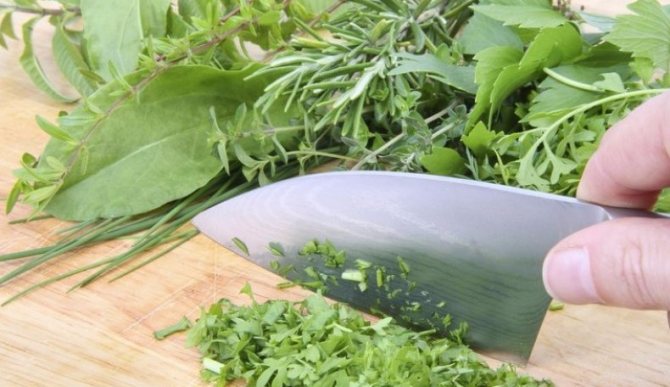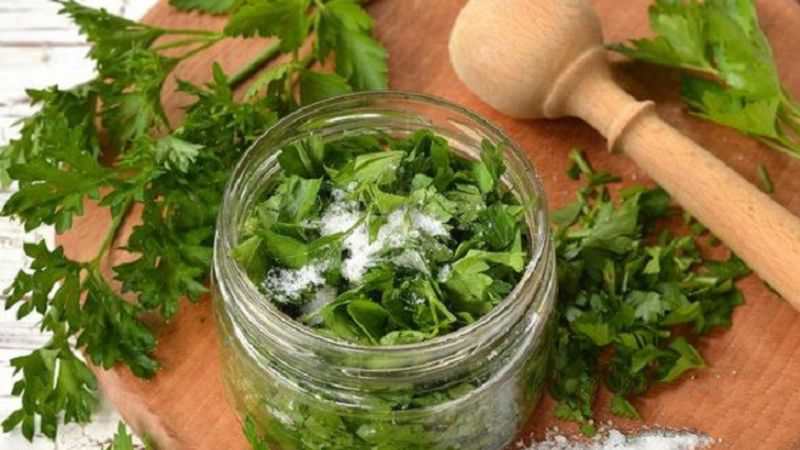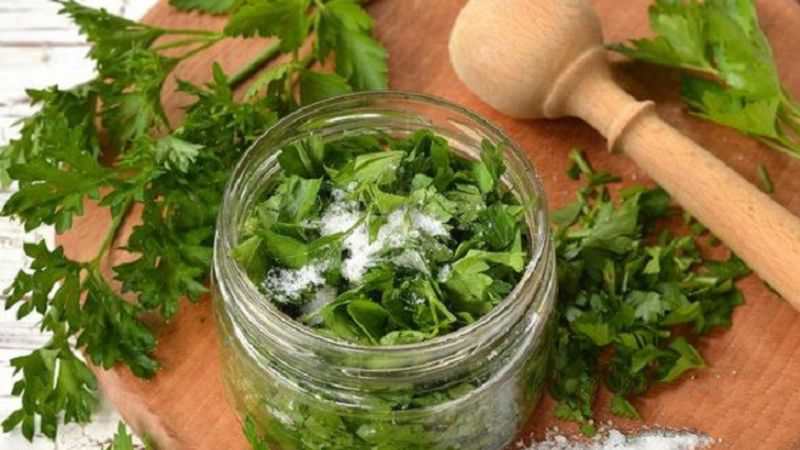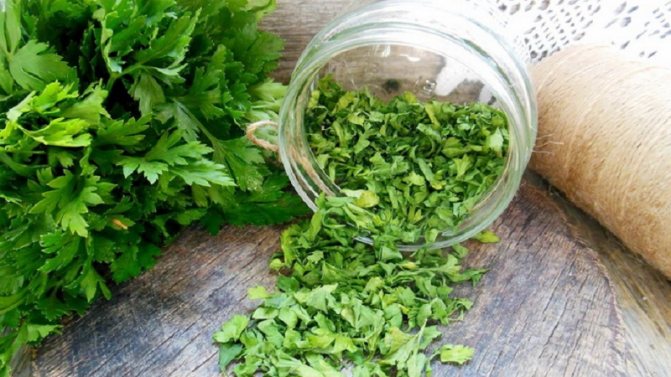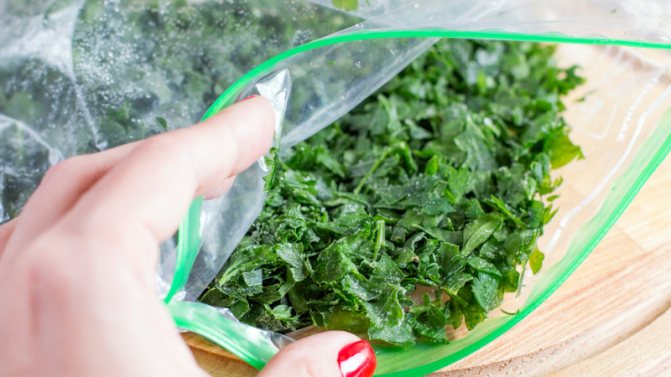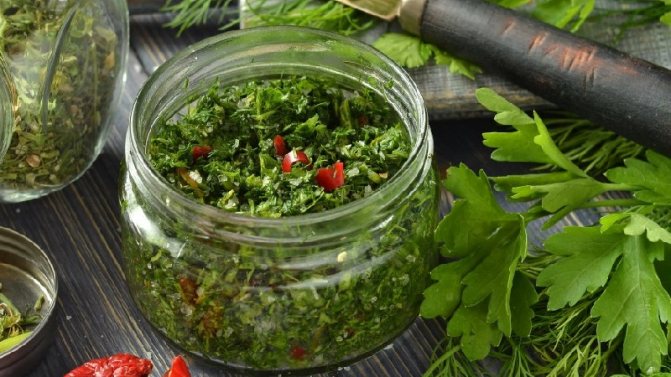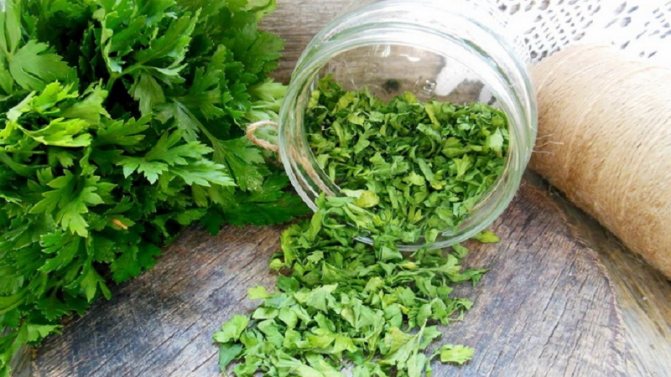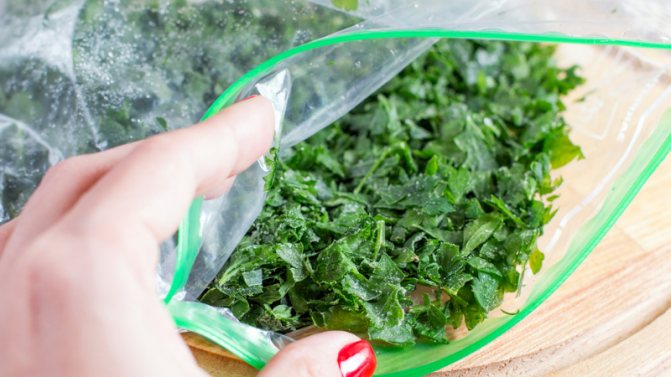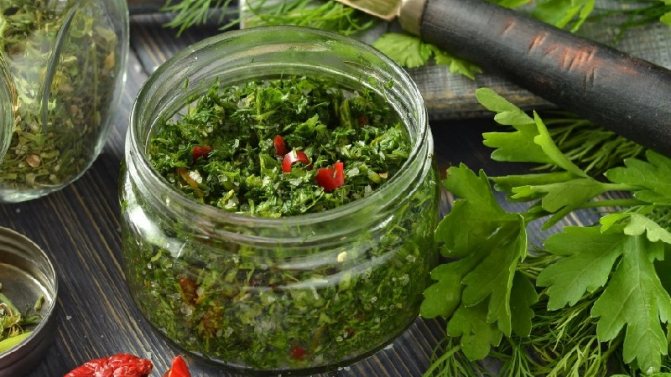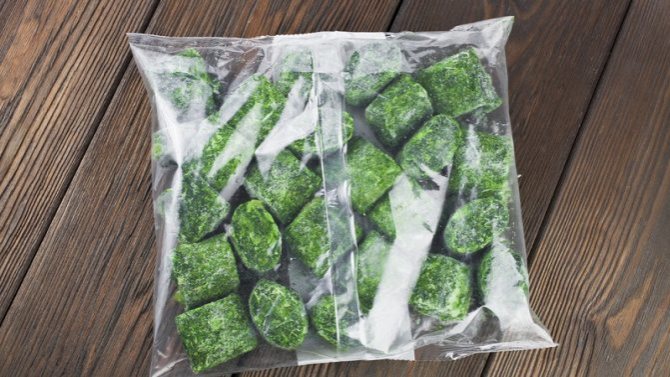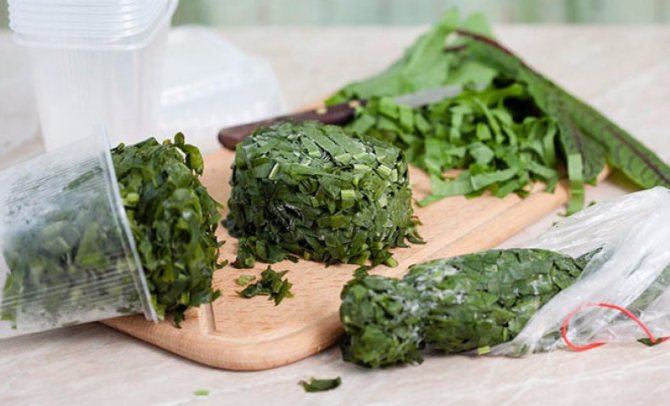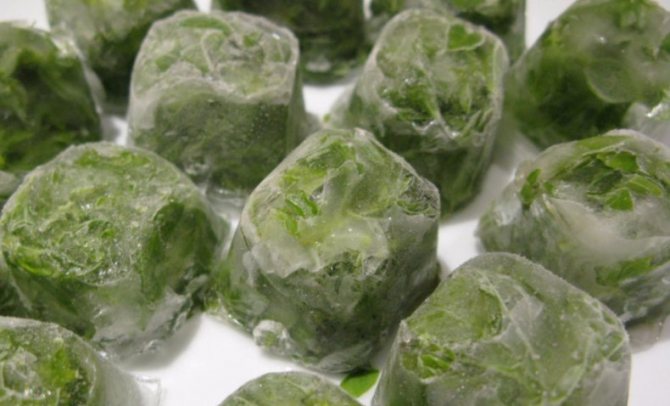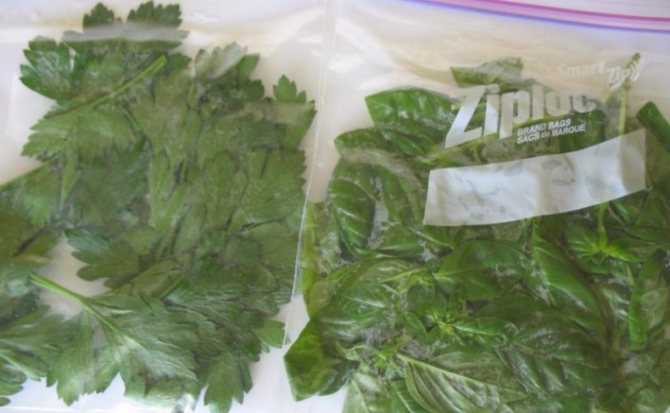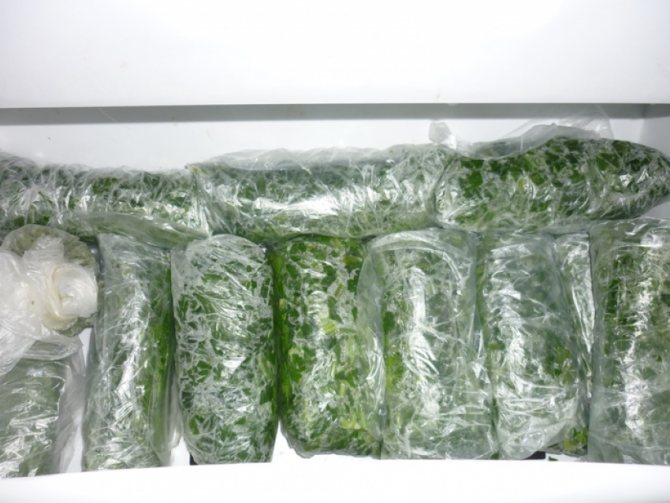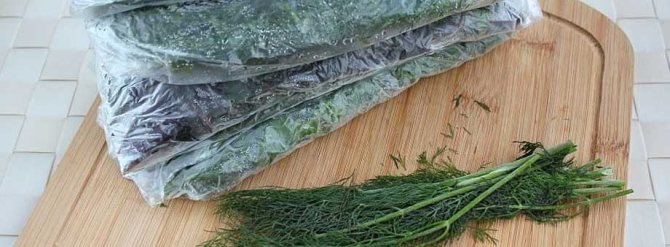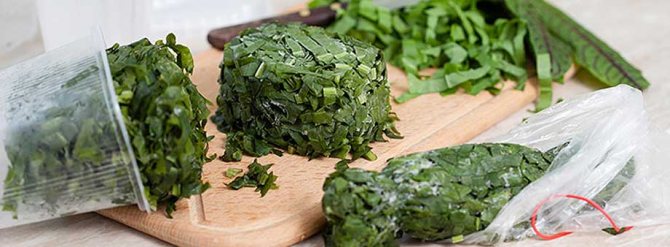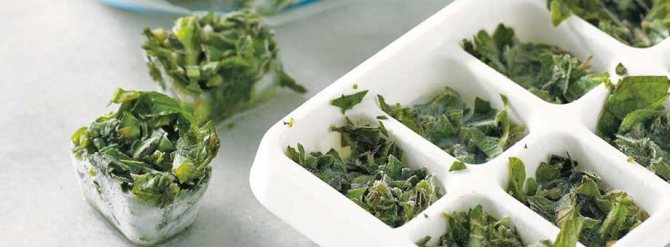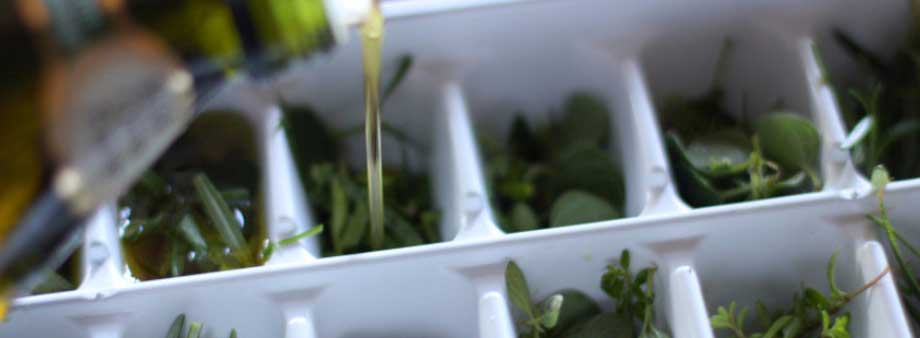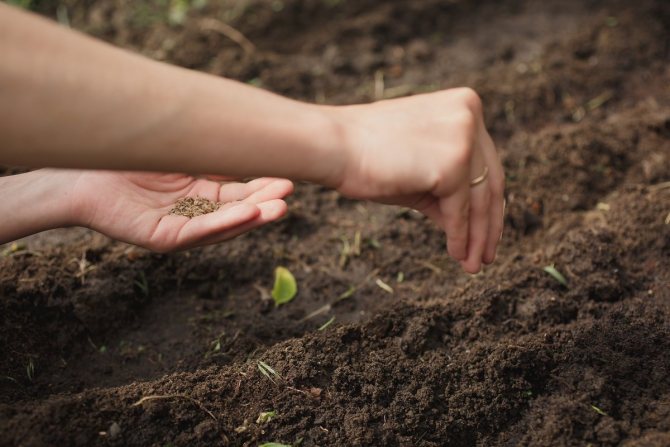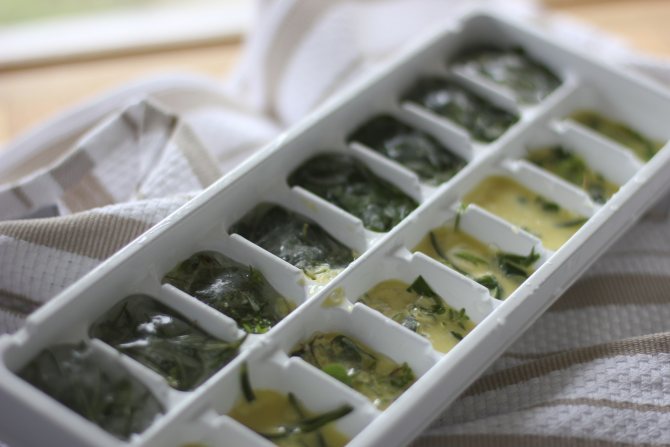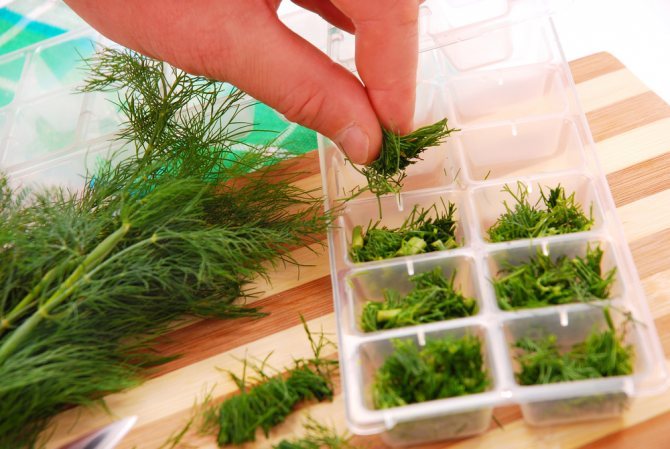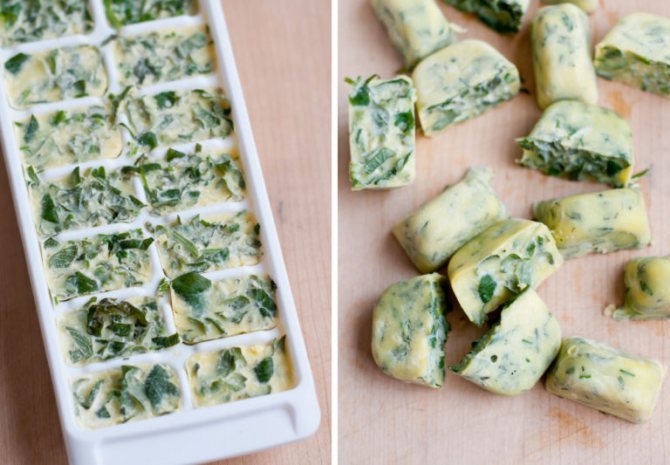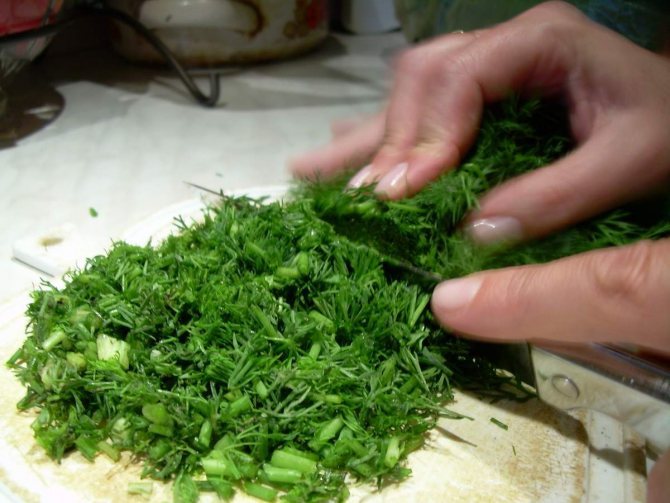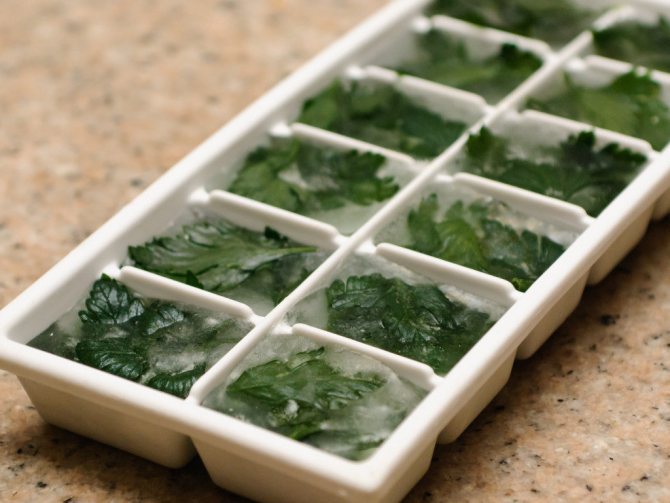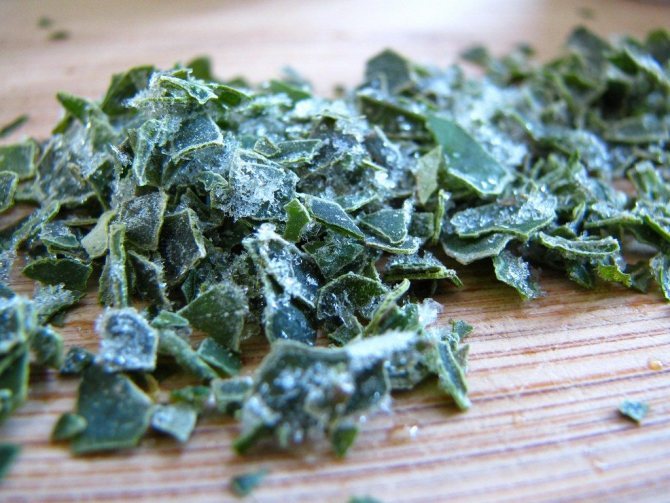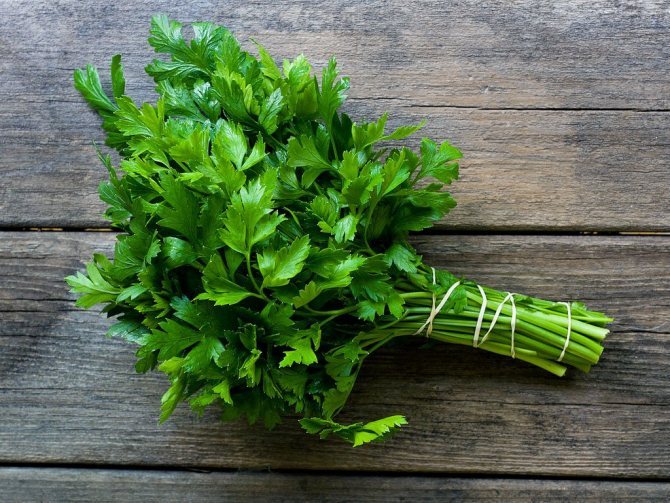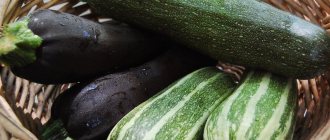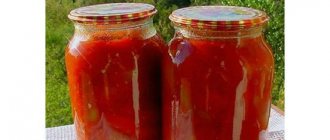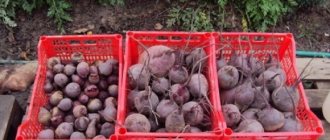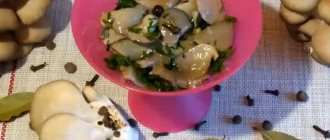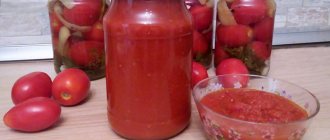The author of the article
Daria Vorontsova
Reading time: 10 minutes
AA
Fast freezing of foodstuffs allows keeping their quality unchanged for a long time.
During storage vitamins are not destroyed, taste and aroma are not lost.
Modern freezers allow you to freeze vegetables, fruits, mushrooms and herbs in sufficient quantities for the family for the winter. This makes it possible to consume healthy vitamin products in winter without buying them in the store.
How to properly freeze greens and then use them in cooking is described in detail in this article.
The benefits of parsley and contraindications
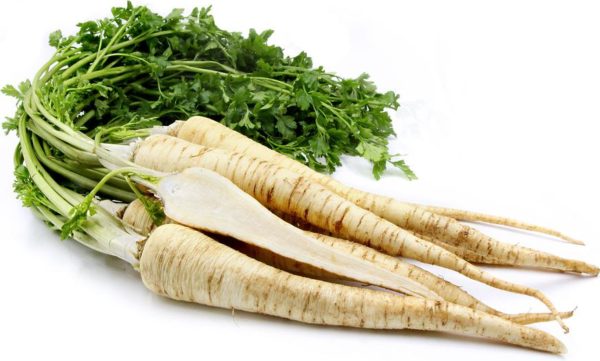
In folk medicine, the root part and shoots of parsley are used, and medicinal decoctions are also prepared on their basis. Parsley is taken for diseases:
- stomach;
- duodenum
- liver;
- kidney;
- organs of the genitourinary system;
- thyroid gland.
In cosmetology, decoctions are used to stimulate hair growth and strengthen hair follicles.
Contraindications to use:
- diseases of the bladder, stomach, liver and kidneys in the acute stage;
- increased tone of the muscles of the uterus during pregnancy;
- exceeding the recommended dosage in the preparation and use of medicinal broths leads to dizziness, nausea, vomiting.
Product features
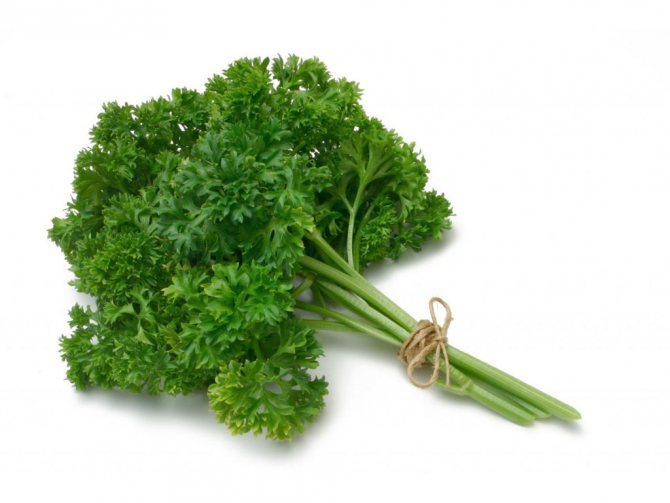

Parsley is a fragrant edible plant that can be grown both in outdoor beds and in a plastic container on a windowsill. It is unpretentious, and with minimal maintenance it gives several harvests per season. In cooking and folk medicine, all parts of the plant are used: the fleshy root and leaves.
Fresh leaves are added to:
- salads,
- hot dishes (first and second);
- in decoctions to strengthen hair;
- in lotions and creams;
- together with the stem, they make smoothies and juice.
Root parsley is used in:
- cosmetology;
- vitamin complexes;
- broths and hot meat and vegetable dishes;
- folk medicine.
Features of storing parsley and types of preparations for the winter
The rules for storing parsley root for the winter and shoots are different:
- The aerial part of the plant is harvested in June to preserve the smell of parsley.
- The roots are harvested at the end of summer - it is at this time that the parsley root must be dried so that the vitamins are preserved in it for the long winter.
Ways to make winter semi-finished parsley products in your home kitchen:
- freezing;
- drying;
- canning with the addition of oil;
- salting.
Frozen parsley: cooking methods and benefits
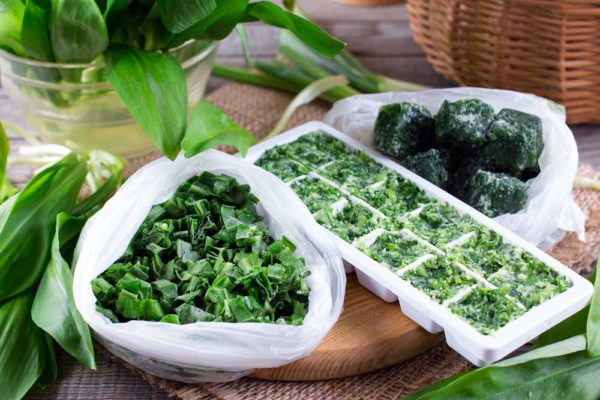

You can freeze the parsley and store the fragrant plant in the freezer to enjoy healthy greens during the winter months. There are three methods on how to properly freeze parsley for the winter:
- in cling film;
- in ice briquettes;
- in packages.
The procedure for how to properly dry parsley at home for frozen storage:
- Carefully rinse the aboveground part with cool running water, remove the coarse part of the plant.
- Place in a colander or spread on a cloth to drain or absorb. You can use an electric dryer.
- Finely chop the dried stems and leaves, tear by hand or grind with a blender. You can form bundles by twisting several plants together and tied with a thread.
- If you pack parsley in cling film: divide the green mass into portions, wrap, pack, keep in the freezer at a temperature of -16 ° C.
- To prepare greens in the form of beautiful ice cubes, distribute finely chopped raw materials into molds, pour warm boiled water into the recesses of the container, allow to cool and put in the freezer.
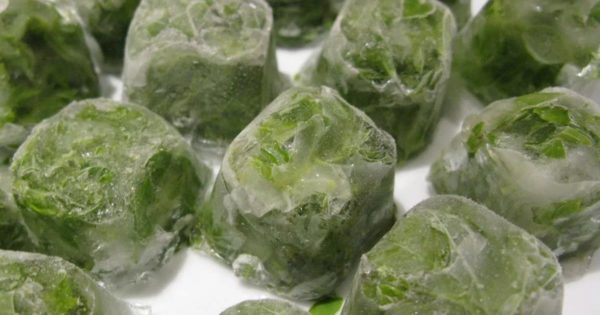

In a solid state in culture for up to 12 months, its healing characteristics remain active and the piquancy of fresh greens remains. Portion ice cubes with herbs are dipped into broths and soups a few minutes before cooking, and bundles frozen in cling film are used to prepare salads and are suitable for serving first and second courses before serving.
The advantages of freezing over other methods:
- preserves the shape, color and smell of fresh plants;
- retains the healing characteristics and activity of trace elements;
- saves time;
- stored for up to one year.
Harvesting parsley for the winter at home is a simple process. You just need to determine what is acceptable for yourself.
How to dry parsley at home or in the country
The root system and shoots of the plant are dried if it is not possible to make blanks in the freezer.
What is the best way to store root parsley for the winter in the refrigerator:
- Rinse the plants, separate the roots.
- Dry on a cloth for an hour.
- Cut the dried parsley into thin slices, sticks or cubes.
- Spread evenly on the tray in one layer.
- Place in the oven and dry with the door open for 5 hours (the recommended drying temperature is 50-60 ° C).
For winter storage, you can dry the root parsley at normal temperature, leaving the slices in a well-ventilated area for about a day. After drying, put the parsley root in jars or any other containers with a tight lid.
How to dry greens:
- Peel and sort the stems, separating the withered and crumpled leaves. Rinse.
- Chop or tear finely.
- Spread thinly on a tray.
- Leave in a cool, unlit place until moisture naturally evaporates.
In order to cook dried parsley in the form of herbs or finely chopped root, you can also use modern kitchen "helpers" - a microwave oven or an electric dryer. The finer the shoots of the plant are cut, the faster the cooking process will complete. In dried form, root parsley or herbs can be stored for up to two years without losing their beneficial properties.
How to make a blank using oil
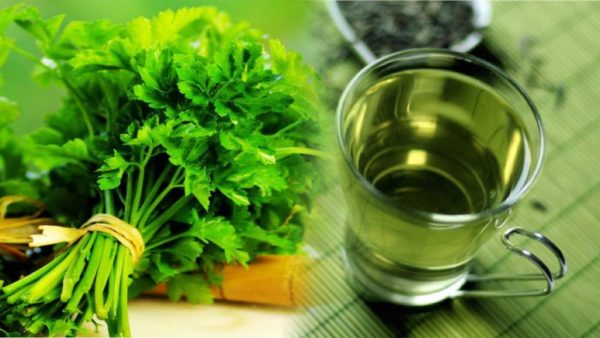

As in the case of drying the product, greens and root vegetables should be harvested separately. The roots must be cut with a sharp knife as small as possible, while not using a blender (otherwise additional moisture will be released from the plant). Shoots can also be dried well on a towel or in an electric dryer.
- Rinse the glass jar and lid well in hot water and sterilize.
- Carefully, layer by layer, place the resulting raw material in the jar, without squeezing or crushing the green mass.
- Pour any kind of refined or unrefined oil into a container.
- Store the parsley prepared in this way in the basement, cellar or refrigerator.
For the preservation of the finished product, the green mass must "sink" in the oil liquid by at least one and a half fingers!
The original way to prepare a green plant is to freeze it in butter in a chamber. For this:
- Gently rinse the green part, chop and dry slightly.
- Distribute over the honeycomb of the ice container.
- Heat the oil to a liquid state and cool to room temperature, preventing it from hardening.
- Pour green raw materials with thick solidified oil and freeze in the same way as in the first method with water.
The main advantage of cooking herbs with oil is to preserve the pure aroma of the plant for a long time.
How to pickle parsley for the winter
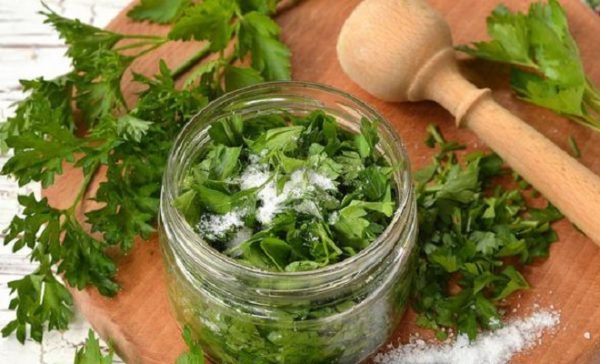

There are two main ways to pickle parsley for the winter:
- classic and fast - no heat treatment;
- canning in spicy brine.
Salting parsley with salt without marinade is the easiest way. Suitable for both whole stems of the plant, and in order to retain the odors of finely chopped green mass.
- Separate the greens from the roots.
- Place whole branches or chopped raw materials in a sterilized glass jar. Finely chopped greens are allowed to be lightly tamped.
- Sprinkle with salt in a ratio of 200-250 grams of salt per 1 kg of parsley.
- Cap tightly, store in refrigerator, cellar or cool place.
- In order to avoid mold, additionally sprinkle the mass with salt.
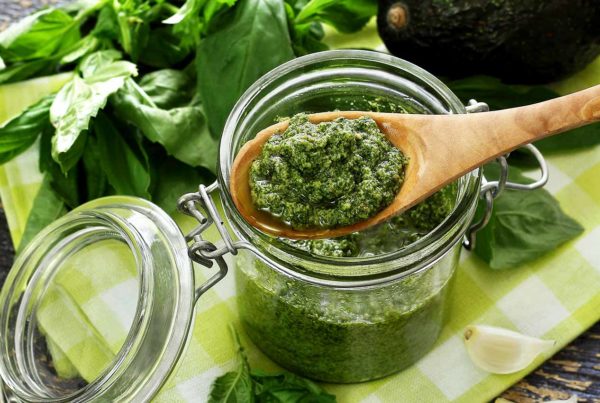

Pickling in marinade is an original method to prepare parsley for the winter. For cooking you will need:
- Rinse parsley, chop, dry.
- Sterilize the glass jar and lids.
- Put garlic (1-2 cloves), 3-4 allspice peas and bay leaves on the bottom of the jar.
- Prepare the marinade: boil water in a saucepan, salt and add sugar. Add vinegar, stir and remove from heat.
- Put parsley in jars, tamp tightly, pour hot marinade.
- Sterilize and roll up cans with blanks.
- Allow to cool. Store salted parsley in the refrigerator.
Vitamin preparation with parsley for the winter
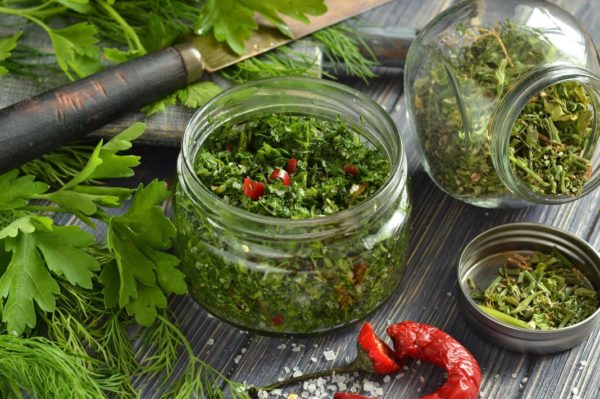

You can salt the parsley by adding other greens to the preparation - celery, dill. Recipe for vitamin dressing for salads and soups from parsley, celery and dill.
- 1 bunch of young dill;
- 1 bunch of parsley (several varieties can be used);
- 3 stalks of celery;
- salt;
- pepper;
- vegetable oil.
- Rinse greens, dry, chop finely.
- Cut the celery stalks into cubes.
- Put in a jar, sprinkle with salt and pepper.
- Tamp well, cover with vegetable oil.
- Close the lid tightly.
The vitamin mixture is stored in the refrigerator for 4 - 6 months, suitable for salads, soups and main courses.
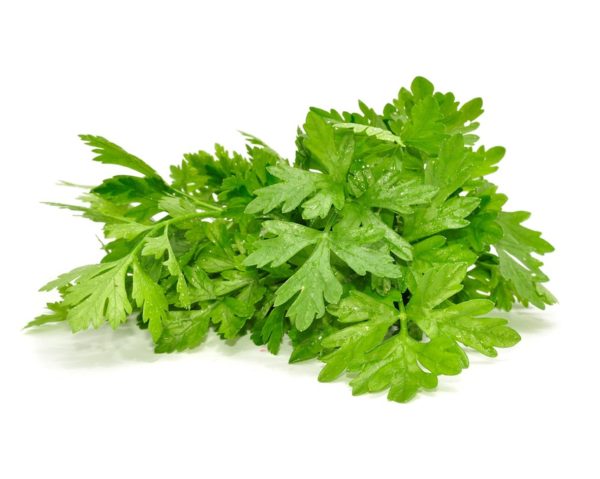

Parsley is an unpretentious garden plant used in cooking, cosmetology and folk medicine, due to the content of beneficial trace elements and an appetizing spicy aroma. You can save parsley for the winter at home in various ways - freeze it fresh, dry it and even pickle it in a marinade. This piece of fragrant parsley will be a great reminder of summer and will decorate any dish. Save parsley root for the winter - provide yourself and seven vitamins for the whole winter.
Preparing greens before freezing
All herbs must be thoroughly rinsed with cold water, sorted out and dried. Excess moisture remaining on the leaves will create an additional volume of ice when frozen. It's not needed.
Helpful information
Daria Vorontsova
An amateur gardener. He is fond of growing various greens at home.
To remove small insects and slugs from lush twigs, it is enough to hold the grass for half an hour in salt water. All living creatures will float to the surface, and it is easy to throw them away. After a salt bath, the greens are rinsed with running water.
For soup
Already chopped greens are added to liquid dishes. Therefore, before freezing, parsley, dill, sorrel, nettles and ash (useful herbs are harvested in the spring, when they contain a maximum of vitamins) are cut as is customary for the hostess.
It is convenient to immediately make up a mixture of herbs, which is usually put in a particular soup.
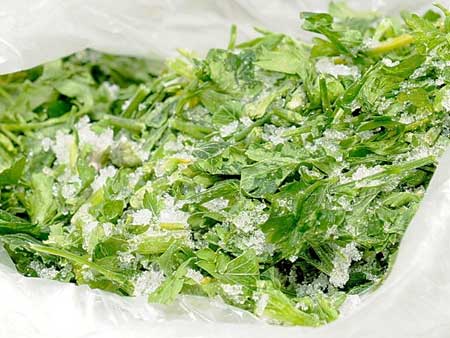

On the bag, you must indicate the composition of the frozen mixture and the date of freezing so as not to get confused during cooking.
During the cooking process, frozen greens are added to the dish before serving. A couple of minutes is enough for the greens in the hot broth to thaw, but not to lose vitamins.
For decorating dishes
For these purposes, the product is harvested with whole beautiful twigs. Sprigs of parsley and dill look especially impressive. They are laid in loose small bunches, wrapped in cling film. The large coarse stems are cut and can be frozen separately to flavor the broths. To keep the leaves intact, the greens must be dry before cooling.
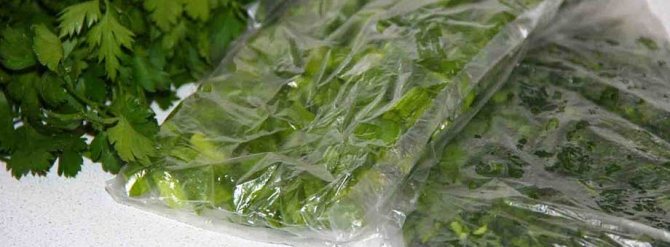

For tea
Mint, lemon balm, thyme, currant leaves, raspberries, rose hips and apple-tree flowers are all excellent raw materials for making tea collections. Chopping the grass before putting it in the freezer is optional, you can roll the leaves or close them in an envelope.
Sometimes fresh berries of raspberries, currants, strawberries, rose hips, barberries, cherries, apple slices, quince are added to the leaves. This will enhance the aroma and add flavor and vitamins to the drink.
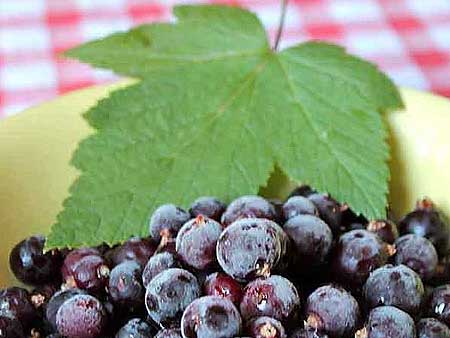

Nuances and rules of preparation
It is necessary to prepare a container for freezing (bags, molds), a permanent marker and thick paper for writing in advance.
After washing the grass, it is dried at room temperature for no more than an hour so that the greens do not wilt. To speed up drying, the twigs are laid out on paper napkins or towels and blotted out excess water.
It is recommended to freeze ramsons and garlic arrows finely chopped. Sometimes they are blanched in boiling water, dropping greens in a sieve. Heat treatment time - no more than 10 seconds.
Lettuce leaves and arugula, green onion feathers are added chopped into frozen mixtures for adding to soups, stews.
Why parsley is useful
It is difficult to overestimate the degree of usefulness of greens, since the therapeutic effect on the human body is very great. The multifaceted influence of the constituent elements leads to an increase in the general tone.
The effects of parsley on humans are:
- improving the work of the adrenal glands;
- improving metabolism;
- anti-inflammatory effects;
- strengthening of blood vessels;
- ensuring the normal functioning of the brain;
- improving the condition of the body in diseases of the stomach and duodenum;
- stimulation of digestive enzymes;
- stimulating appetite;
- the emergence of a feeling of satiety;
- beneficial effect on the organs of vision;
- strengthening the gums and more.
When consuming parsley in any form, do not forget about contraindications. In addition to good, it also brings harm. You should consult your doctor before self-medicating.
It is undesirable to use parsley for those who:
- suffers from diseases of the bladder, cystitis, urolithiasis,
- has chronic diseases of internal organs,
- has a tendency to allergies.
Everything is good in moderation - no need to abuse, and there will be no harm from the use of culture.
Does frozen parsley retain its beneficial properties?
The frozen product retains its beneficial properties. Eating fresh or frozen parsley regularly:
- strengthens the immune system;
- lowers blood sugar levels;
- stimulates the digestive system;
- increases appetite;
- improves the functioning of the heart and blood vessels;
- removes toxins and toxins from the body;
- has a beneficial effect on vision.
Parsley is a natural antiseptic, has diuretic properties, reduces the intensity of menstrual pain, and prevents the development of prostatitis in men. It is used in cosmetology as a means of cleansing, healing and toning the skin.
But it is worth refraining from using parsley for cystitis, urolithiasis, diseases of the bladder, liver diseases. It is not recommended to eat greens during pregnancy.
We prepare the necessary ingredients
When collecting greens for storage, it is worth considering several rules under which parsley will retain the maximum useful properties:
- The green part of the plants is harvested at any time. The vitamin reserve concentrated in the leaves does not change in different periods of the growing season.
- The roots are assembled only in the fall, since it is at this time that they are filled with the maximum amount of nutrients.
Before you start harvesting parsley, you need to separate the green part from the rhizome. Sort out all the leaves, removing dry, yellowed specimens.
Wash all components and dry well. Then decide on a method of preservation in the winter. It depends on the time the housewife has at her disposal and the personal preferences of family members.
Useful video
Another original way: freeze greens in a plastic bottle.
If you find an error, please select a piece of text and press Ctrl + Enter.
If growing parsley year-round is not possible, there are ways to keep the medicinal plant fresh for the long winter months. The plant does not withstand long-term fresh storage - the aromatic culture, after being harvested, withers and withers in a warm room for several hours. Shredded, it is recommended to immediately serve. In the refrigerator without freezing, parsley can be stored for up to three days. There are several ways to keep parsley fresh for the winter.
Methods for preparing parsley for the winter
For every housewife, there are recipes suitable for her preferences and wishes. One has only to search a little. It is not difficult to create suitable home conditions for workpieces. And the resulting seasoning compensates for all the expended forces.
For the winter, the whole plant is harvested, there are not many ways to accomplish this task:
- Drying. The roots and leaves of plants are dried in the oven or in the fresh air.
- Freezing. The crushed parts of the culture are frozen and stored in a freezer.
- Pickling or salting. Chopped greens and chopped roots are pickled or salted.
- Oiling. The billet is mixed with oil and stored in the refrigerator.
You should choose a method for preserving culture by studying the recipes.
Dried parsley
There is nothing difficult in drying parsley. It is enough to fulfill a few requirements, and everything will work out.
How to dry the plant and preserve the aroma - this question is asked by many housewives. Compliance with the requirements and rules leads to the fact that parsley retains not only smells, but also mineral components.
The advantages of this method are that parsley loses weight and becomes leaner. And it is easier to store it, and it does not require special conditions.
To prepare green mass or roots for future use, they are well washed and dried. Then they sort it out, removing unsightly, sick and deformed specimens. At the end of sorting, the roots are cleaned.
Greens are dried in a whole bunch, together with the lower part of the petiole, or each leaf individually.
The roots, depending on the size, are cut into circles or cubes. The prepared raw materials only need to be dried. They do it in different ways.
On open air
This method is long-term, but the effectiveness does not suffer from it. Greens are dried in whole branches or chopped in such a way as for immediate consumption.
To dry it, place it on a plane, evenly distributing it over the surface on which it is dried. The thinner the layer, the faster the raw material will dry. Lay out no more than 1 centimeter thick.
Greens collected in bunches are hung under a canopy or in another well-ventilated area. The leaves should hang down. It is advisable to exclude direct sunlight on the foliage, as it will turn yellow and lose its attractiveness.
The roots are also dried in the open air, chopping in any way and covering with gauze from insects. Periodically turning the pieces over will speed up the drying process and eliminate debate.
Depending on the accompanying conditions, the plant will have to dry from 5 to 20 days, not forgetting to periodically turn the raw material to speed up the process.
In the oven
It does not take much time to prepare the spice in this way.The seasoning will dry out much faster than in the first case.
It is important not to overdo it with the temperature, because the higher it is, the faster the roots and greens dry. But the appearance and the complex of nutrients that make up their composition suffer from this.
The optimum temperature is 40-60 ⁰С. The washed and peeled roots are cut into cubes or slices and laid out on a baking sheet. Greens are laid out in twigs or cut and distributed in a thin layer.
Dry with the door open, the approximate time spent in the oven is 5-6 hours. Finely cut raw materials dries several times faster.
In an electric dryer
This kitchen assistant will always help out the housewife. You don't have to do anything special, the roots must be cut, and the green branches are laid out entirely.
Set the mode "For herbs", and set the temperature to no more than 45 ⁰С. It is necessary to periodically monitor the process, swapping the pallets. It is difficult to indicate the exact time, it depends on the accompanying factors: air humidity, slicing thickness and much more.
In the microwave
Put the parsley on a plate, preferably flat, cover the bottom with a napkin. The power of the device is maximum. The time for which the raw materials are placed in the microwave is 2 minutes, then you should look at the appearance of the plant. If it is not dry enough, put it on for another 2 minutes. And so on until the mass reaches the desired state.
Parsley salting
An effective way to preserve crops for the winter is to sprinkle with salt. There are many recipes for its preparation. It is required to choose the most suitable method.
Twigs
Salting in this way is not difficult, a minimum of ingredients are used:
- parsley - 400 grams;
- salt 100 grams.
The greens are sorted out, washed with running water and separated from the coarse stems. The prepared glass container is scalded with boiling water. The twigs are mixed with salt so that it is evenly distributed. Then they are laid out in jars and put away for storage. A refrigerator, balcony or other cold room will do.
In the classic way in the bank
A proven method for years, preserves the beneficial substances that make up parsley. No additional ingredients are required. All unusual methods take a lot of time to prepare, and this recipe is simple and equally useful.
- parsley - 300 grams;
- salt 3 tablespoons.
Well-washed greens are wiped off with a towel, chopped and rubbed with salt. The more carefully they do it, the better.
The resulting mixture is tamped into sterile jars and closed with any lids, at the discretion of the housewives.
The lid should close tightly without letting in air. This will prevent signs of spoilage from appearing.
Salted seasoning keeps well in the refrigerator or cellar. Mold can develop at room temperature. Any dishes and salads are prepared with this parsley.
With the addition of dill
To salt parsley with dill, you need a minimum set of ingredients. And the benefits increase several times. The amount of greens is determined by the housewife, it is important to observe only the proportions of salt. If there are more of any raw materials - it's okay.
- equal amount of dill and parsley;
- salt at the rate of 200 grams per 1 kilogram of green mixture.
The green part of the plants is washed well with water, then be sure to dry. Raw materials are crushed in any convenient way.
Dried parsley is a worthy alternative to freezing
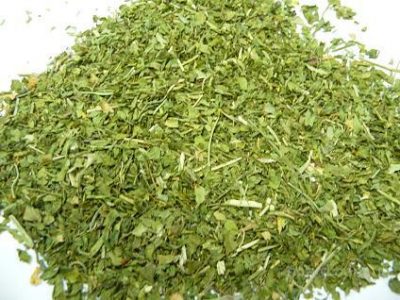

If for some reason it is not possible to store greens in the freezer, they should be dried. The seasoning processed in this way is compact in storage, and also contains almost all vitamins and mineral salts that fresh parsley is rich in. You can dry spicy herbs in the following ways:
- on open air;
- in the oven;
- in a microwave oven;
- in the dryer for vegetables and fruits.
Drying in the open air
With natural dehydration, parsley with dense leaves is cleaned of rotten parts and impurities, rinsed thoroughly and dried with paper towels.
Next, the greens are either cut and laid out in a thin layer on paper sheets, covered with gauze, or hung in bunches on a rope.
Important!
During drying, the grass is protected from direct sunlight, which destroys chlorophyll. Turn the chopped parsley regularly and stir the bunches to avoid mold or decay.
The drying process takes up to 7 days.
Drying in the oven
Happens much faster, however some of the nutrients are destroyed by high temperatures.
The leaves, peeled from the stems, are scattered on a baking sheet covered with parchment and sent to the oven, preheated to 45 - 50 ° C. The door does not need to be closed to allow moisture to escape. From time to time, the leaves move, otherwise they may burn.
How to properly store dried parsley at home
Well-dried leaves are easily separated from the stems and crumble when squeezed. The resulting seasoning is poured into glass jars with tight-fitting lids or paper bags foiled from the inside.
It is better to store parsley in a dry, dark place.away from stoves or heating appliances. It does not lose its taste and useful properties for 2 years.
Freezing parsley
An equally effective way of harvesting greens for the winter is freezing. The culture retains the entire supply of nutrients, thereby helping to maintain immunity in the middle of winter. It will take very little time and effort to freeze plants. There are 3 ways, which one is the best, the hostess herself will decide.
In the package
All you need is parsley. The quantity is not limited. The leaves are well washed, sorted and dried.
If the greens sit for more than 30 minutes, they will begin to wilt. This will complicate the process of preparing the workpiece.
Drying using a towel will be quick and effective. Then it should be cut in any way or as for immediate dressing of the dish.
The prepared chopped green mass is laid out in bags. Do not freeze in large quantities, it is not advisable. After repeated defrosting, the leftovers will turn black and will not go to the dressing. Next, the bags should be frozen.
Cubes in ice cube trays
A more laborious way of harvesting greens in the winter. You will need boiled water and herbs.
The parsley is washed several times in cold water. It is not necessary to dry, as it is filled with water. Chop finely, it will be easier to tamp into small cubes.
They are laid out in molds, compacted and filled with chilled water. Put in the freezer for several hours. After the cubes are frozen, take them out of the mold and put them in bags. For convenience, they sign.
In bunches
This is the fastest way to preserve the greens, but you should dry them well. The bunches are formed on the basis of one preparation or two. The leftovers will lie in the refrigerator for several days, no more.
The finished bundles are wrapped in pieces of cling film or put into a plastic bag. And sent to the freezer on demand.
Harvesting fresh parsley in vegetable oil
To properly prepare a dish according to this recipe, you do not need to do anything special. Greens are prepared in the same way as with other storage methods for the winter.
Parsley is chopped and placed in a dry container. In this case, there is no need to ram; then pour in vegetable oil and store the dressing in the refrigerator.
Parsley marinated
The appetizer is made a little more difficult than the previous recipes, since the marinade should be prepared.
- parsley;
- horseradish, cherry, currant leaves;
- garlic - 2-3 cloves;
- salt, at the rate of 1 tablespoon per liter of water;
- bay leaf, allspice;
- 70% vinegar - 0.5 teaspoon per 1 liter jar;
- water.
The preparation for the winter should be done like this.Parsley is washed and sorted, cut in an arbitrary way. Spread in jars, with pre-added cherry leaves, currants, horseradish and garlic cloves. Prepare a brine: 1 tablespoon of salt for 1 liter of water. Poured into ready-made jars and closed with lids. Sterilized within 15-25 minutes, depending on the size of the container. Roll up and put into the cellar for storage. It is better to prepare such a seasoning in the summer, when the greens are most rich in vitamins.
Is it allowed to re-lay the spice in the cold?
Re-freezing greens is not allowed. Weakened by repeated freezing and thawing, cell membranes burst, and vitamins and minerals contained in cells are destroyed. Parsley after repeated freezing does not provide any benefit to the body.
Read about the varieties of parsley, how it differs from cilantro and celery, the peculiarities of seeds and the ban on the curly variety in Russia on our website.
Frozen parsley is a summer vitamin "hello" for winter soups and salads. Frozen aromatic spice in taste and health does not differ from fresh bunches... The main thing is to accurately follow all the stages of preparing and freezing parsley, and the vitamin seasoning will be preserved until spring.
Canning
Preservation is one of the ways to harvest parsley for a long shelf life. Even a beginner will not have any difficulties with cooking. The main preservative in all recipes is vinegar.
To prepare the workpiece, you will need directly greens, vinegar and salt.
Parsley is cooked like all other recipes. Rinse well and dry. Cut into pieces of 5 centimeters long. They are carefully placed in jars, then the brine is prepared. For 1 liter of water, 1 tablespoon of salt.
Add 2 tablespoons of 6% vinegar to the finished jars and pour in brine. Do not top up to the top, leaving about 2 centimeters.
Placed in a container for sterilization. Boil time is about 10-15 minutes. As soon as they are ready, the cans are rolled up and removed until they cool completely under a blanket or blanket.
Fresh parsley preparations
Freezing is not the only way to store garden herbs at low temperatures.
Parsley drenched in vegetable oil
The leaves are washed and finely cut, and then poured into glass jars, lightly tamping the mass. Then the container is gradually filled with refined vegetable oil, making sure that no air bubbles form.
Oil is poured in portions - then it fills the gaps between the herbs as much as possible.
The jars are closed with polyethylene, or even better with vacuum, lids and stored either in the cellar or in the refrigerator at + 7 ° C.
Salting
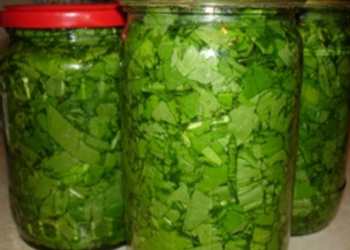

Parsley is crushed and placed in pre-sterilized jars, sprinkled with layers of coarse salt.
Greens and preservatives are taken in a 5: 1 ratio, respectively.
Salted parsley is stored similarly to the preparation with vegetable oil.
Used as a dressing for soups and main courses.
Parsley marinated
Two more options for keeping parsley in the refrigerator for the winter without freezing.
Recipe number 1
- 1 bunch of fresh parsley
- ½ l of water;
- 2 tbsp. l. Sahara;
- 2 tbsp. l. coarse salt;
- Bay leaf;
- 2 - 3 cloves of garlic;
- 4 tbsp. l. vinegar.
- Cut the washed and thoroughly dried parsley.
- Place the garlic and bay leaf at the bottom of the sterilized jars. Fill the containers tightly with greens and fill them with hot brine.
- For the marinade, mix water with salt and sugar, bring to a boil, pour in vinegar and immediately remove from heat.
- We sterilize the filled cans within 15 minutes at a temperature of 90 - 95 ° C.
- We roll it up, wrap it up warmly and set it to cool.
The finished preservation can be stored in the refrigerator for no more than 6 months.
Recipe number 2
- a bunch of parsley;
- 1 tbsp. l. with a top of coarse salt;
- 1 l. water.
- We fill sterilized jars with herbs as in the previous recipe. Fill the leaves with a saline solution heated to 80 ° C and leave to ferment for 2 - 3 days.Do not forget to remove the foam from time to time.
- We seal the jars with plastic lids and store them on the lower shelf of the refrigerator at above-zero temperatures.
Storage rules
To preserve the workpieces during the winter, simple guidelines should be followed. The storage room should be kept at a constant temperature. The drops should be excluded, this has a bad effect on the spin.
The approximate temperature regime for the preservation of the product is 0 ⁰- + 10 ⁰С. Humidity is 80%.
Frozen greens should not be thawed and re-frozen, this will cause the mass to turn black and become unsuitable for human consumption.
Store dried herbs in a tightly closed glass container in a dark, dry place.
Seasonings prepared according to recipes require a cold storage for long-term storage. A refrigerator, glazed balcony or cellar will do.
Harvested greens, which, if necessary, are always at hand, helps out perfectly in the middle of winter. In addition, it helps to maintain the body during a period of vitamin deficiency.
Most housewives use herbs as a seasoning for hot and cold dishes. Therefore, the question of how to preserve parsley for the winter at home does not lose its relevance during the entire summer season until late autumn. The fragrant leaves retain their original properties even after heat treatment, and they are preserved in various ways.
This article presents the most common methods for storing these greens at home.
Can greens be frozen at all?
Nutritionists strongly recommend consuming fresh herbs every day. In winter, when only greenhouse herbs of dubious use are sold in stores, greens frozen in summer will come to the rescue.
Vitamin C is fully preserved only in quick-frozen greens.
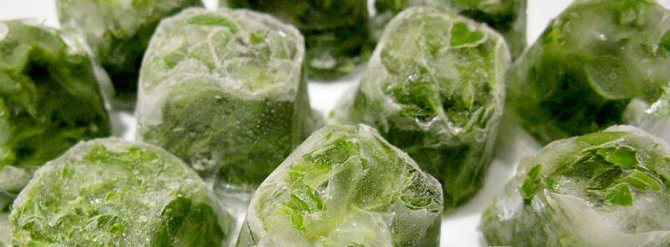

What greens can you freeze
The short answer is any. But harvesting by freezing will bring the greatest benefit to such herbs:
- parsley;
- spinach;
- dill;
- sorrel;
- celery;
- tarragon;
- arrows of garlic;
- wild garlic.
These herbs not only retain their taste and aroma after thawing, but also do not lose their attractive appearance.
What greens cannot be frozen
Green onions, salads have a delicate structure and after thawing they lose their appearance, spreading like wet paper.
This is due to the excess amount of moisture in the structure of the plant. When frozen, it transforms into ice, breaking the walls of the vessels in the plant and turning the thawed product into an unappetizing mess.
These types of plants can be included in frozen ground mixtures, then the unsightly appearance of the product will not be too noticeable.
Cooks are not advised to freeze basil (any color). It is believed to lose flavor after thawing.
olga_dietolog
khamishka
menunedeli
beautiful_young_garden
Storage periods
The shelf life of parsley depends on the storage method:
| Parsley storage method | Shelf life |
| In a refrigerator | 14 days to 3 months |
| Freezing in bunches | Up to 6 months |
| Freeze in cubes (in butter) | 3-6 months |
| Salting | 10-12 months |
| In sunflower oil | Up to 6 months |
| In brine or marinade | 12-18 months |
| Dried | 12-24 months |
In what form and how to properly freeze parsley
Parsley can be frozen in bunches, whole branches, or chopped.
For storage, use plastic bags, cling film or sealed containers.
Advice. Use small containers for storage so that the product has less contact with warm air when opening the container. The quality and shelf life of the frozen product depends on this.
To make it easier to find the right product in the freezer and keep track of the expiration date, the storage containers are marked with the date and name.
Fridge and freezer storage
The aromatic herb can be kept at home until the next harvest and even longer.If you collected greens at the end of autumn, then save them at least until the new year. without pre-treatment will not be difficult. To do this, take a glass jar with a screw cap, wash and sterilize it.
Tear off the leaves from a bunch of greens, transfer them to the prepared container and place in the refrigerator. In this case, the parsley must be unwashed and completely dry. Screw-top jars are best suited for this method of savings. If necessary, simply remove the correct amount of seasoning and screw the jar tightly back on.
In a hermetically sealed plastic bag, greens can lie on the vegetable shelf of the refrigerator for up to 14 days.
If you want to preserve a healthy plant longer, resort to freezing it. There are many techniques for storing herbs in the freezer. The easiest way freeze greens in bunches... Go through the stems and wash them well under the tap. If the parsley is very dirty, soak it for 5-10 minutes in cold water and then rinse thoroughly.
Wet greens must be completely removed from moisture by blotting with a towel. Next, form bundles, each about 30-50 g, wrap them individually in bags and put everything in one container.
Planning to use greens exclusively in soups? Then it will suit you freezing parsley in ice cube trays... After washing and drying the branches, chop them and place them in the recesses of the mold. Fill each compartment 2/3 full and cover with water or melted butter.
How to store in the winter at home: step by step instructions
At room temperature
Heat has a bad effect on the preservation of the beneficial properties of parsley, at room temperature it can be stored for only a few hours, then it will begin to wither. In a warm room, greens very quickly lose vitamin C. It is possible to increase the freshness of parsley by 3-4 days if it is tightly wrapped in parchment or a napkin and put in a dark, cool place. Or put greens in a container, just like flowers are stored in a vase.
In a refrigerator
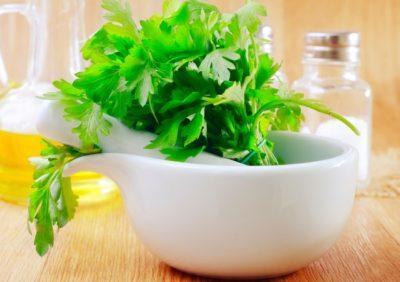

With the following tips, fresh parsley can be kept in the refrigerator for at least a week.
- Method number 1.
- Rinse the parsley well in cold water. Better to wash in a deep dish rather than under running water. After washing, you do not need to drain the water from the container, but just get the greens. This will leave all the sand on the bottom of the dishes and not on the greenery. Then you just need to rinse the greens under the tap.
Place the washed parsley on a dry towel and leave to dry for fifteen minutes.
- Place dried herbs in a container with a tight-fitting lid. A jar with a lid is also suitable for storage.
- Put in the refrigerator.
- Method number 2.
- Rinse the greens, dry them slightly and put them in a plastic bag.
Open the bag completely to draw in air.
- Tie the bag tightly.
- Store in the refrigerator on the bottom shelf.
- Method number 3.
- Rinse the parsley, pat dry with a towel.
Wrap in kraft paper or thick paper towel.
Do not use newsprint because the paint is harmful to health. - Spray paper with water from a spray bottle.
- Wrap the bundle in a plastic bag.
- Put in the refrigerator.
- Method number 4.
- Trim the roots of the parsley.
- Dip the bunch into a jar of water.
- Cover with a plastic bag.
- Change the water every other day.
- Method number 5.
- Sort the parsley, but do not wash.
- Put in a plastic bag.
- Send one or two onions unpeeled and cut into four parts there.
- Tie the bag tightly.
- Once every five days, take out the package, remove the greens with onions, wipe the package dry and fold the greens again. Onions should be replaced each time.
In this way, the greens will last for about a month.
This method will help preserve the greens for a couple of weeks.
Parsley will last 2-3 weeks.
We offer you to watch a video about storing parsley:
other methods
If you have no freezer space at all, you can choose one of the following methods.
In salt
Despite the popularity of freezing, salting parsley for the winter is still a favorite method among thrifty housewives. Salt is an excellent preservative that keeps greens fresh for a long time. This method is easy to implement at home:
- Sort and rinse the herb thoroughly, then pat dry with a towel to remove excess moisture.
- Finely chop the parsley or grind with a blender and mix the blank with non-iodized table salt at the rate of 1 tbsp. l. salt for 200-300 g of leaves.
- When a sufficient amount of juice is released, stir the mass again until the salt is completely dissolved and put it in sterilized jars.
Store the mixture in a cool place under a tin or tight nylon lid. In this form, parsley is saved about 1 year.
When using pickled herbs in standard recipes, remember that additional salt is often not required.
In oil
Another preservative that will help keep parsley fresh for the winter is sunflower oil. Prepare the herbs as described in the previous options, then chop and place in clean, dry jars.
Pour the contents with refined oil and stir the mixture thoroughly so that the liquid is evenly distributed throughout the entire volume of greens. The top of the parsley should be completely covered in oil. Store sealed containers in a cold place up to 6 months.
In brine
Instead of vegetable oil, you can use brine or marinade as a filling. This method will save the product more than 12 months... Arrange the chopped greens in jars and cover with hot brine made from 1 liter of water from 30 g of salt, then sterilize for 5 minutes and roll up the lids.
Use the following ingredients to make the marinade:
- 1 liter of water;
- 50 g sugar;
- 50 g of salt;
- 200 ml of 6% vinegar.
Drying
In order to preserve parsley for the winter, you can use the time-tested method - drying. Typically, these herbs are added to hot dishes to add flavor.
Tear off the leaves from clean stems and spread them in a thin layer on a regular kitchen towel. Leave the workpiece to dry in the fresh air or in a well-ventilated area and stir occasionally.
It is not recommended to dry greens in direct sunlight, as they quickly turn yellow and lose their quality.
If you want to make a concentrated spice, grind the dry leaves in a coffee grinder. A pinch of such seasoning will be enough to give the dish its taste and aroma.
Can dry the parsley along with the stalksby finely cutting the bundles with a knife or scissors. The shredded workpiece is dried as described above, or an oven is used to speed up the process.
Line a baking sheet with baking parchment and lay out the chopped herbs or leaves in an even thin layer. It will take about 2 hours to dry completely. Dry the parsley at a temperature of no more than +40 ℃ for about an hour and a half, then increase it to +70 ℃ and leave the parsley for another 20-30 minutes.
Store the workpiece in hermetically sealed glass or ceramic jars in a dark place up to 2 years... Also, for long-term conservation of dried herbs, fabric bags with ties are suitable.
We hope that our recommendations will help you prepare parsley for the winter in order to preserve vitamins and taste to the maximum.
How to store fresh parsley in season
Even in the season, not every one of us has the opportunity to pick fresh parsley every day in the garden. Greens brought from the dacha or bought on the market have to be stored for a long time. To prevent it from losing its nutritional value, wilting and deteriorating, it is necessary to avoid:
- bright sunlight, from which spicy herbs turn yellow and lose vitamins;
- excess moisture leading to product decay;
- excessive loss of water by leaves;
- access of oxygen, which causes oxidative processes (the appearance of brown spots, a withered look of greenery).
There are several simple and effective ways to keep parsley fresh:
- For 3-4 days, garden greens can lie at room temperature. To do this, it must be thoroughly cleaned of foreign and spoiled twigs, earth and the lower part of the stems. Never wash! Then the whole bundle is tightly wrapped in parchment or a napkin made of natural fabric and placed in a dark, cool place.
- Another option: put the parsley in a wide container, 1/3 filled with water, so that only the stems are moistened, but not leaves. Such a "bouquet" can stand on the table for several days, away from the sun's rays. But it is better to cover it on top with a plastic bag and place it on the bottom shelf of the refrigerator. The water should be changed periodically. At low temperatures, the "life" of a bouquet of parsley will last up to two weeks.
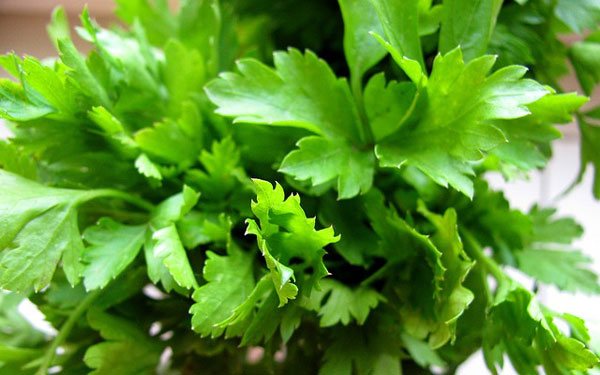

- The sorted, but not washed, parsley can be briefly put on a paper towel to absorb excess moisture, and then put in a plastic bag with holes for ventilation and send to the refrigerator... Even faster, just wrap a bunch of greens with a linen or cotton napkin, and then put it in a bag. The fabric will absorb moisture as well as a paper towel.
Important!Any spicy greens, including parsley, are stored longer and best of all in the “freshness zone”, at temperatures close to 0 ° C.
- Do you want to wash it before storing the parsley? In this case, the spicy grass is first cleaned of debris and clods of earth in a basin of water, and then kept under the tap for a short time, removing the remnants of dirt. Then each branch is dried with a paper towel and laid out on paper.
Attention!It is important not to store greens damp. When no water drops remain on the leaves, parsley
put in sealed plastic containers or jars with screw caps and placed in the refrigerator... With this method, our favorite spice will stay fresh for at least a month. I'll tell you a secret that I use this method most often. - Washed greens can also be stored wrapped in water-dampened kraft paper. The package is additionally placed in a plastic slider bag and placed in the refrigerator. Parsley will "hold out" for 2 - 3 weeks.
A month is a long period when it comes to storing such a delicate product as fresh herbs, but this is not enough for winter preparations. Nevertheless, I would like to save a "piece of summer" for the cold days.
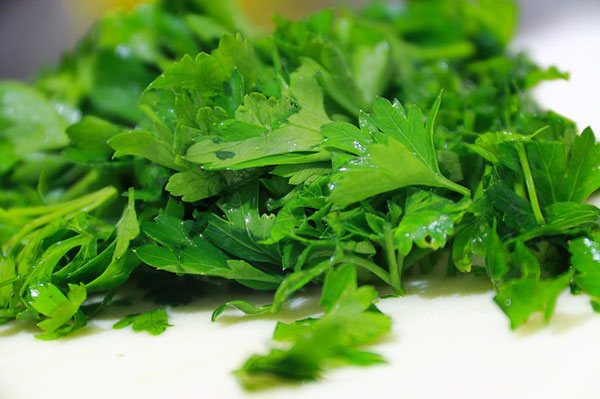

Next, we will tell you how best to keep parsley fresh for the winter, so as not to deprive yourself and loved ones of the vitamin seasoning.
Freezing the plant
Freezing parsley is the easiest way to preserve all the minerals and vitamins of a healthy plant. Most often, this method is used to harvest grass leaves.
There are several options for freezing parsley, but for each of them, a spice plant must be prepared. Preparation consists in washing the plant and separating rough and damaged stems. Such a blank can be stored in the freezer for up to 10 months, so there will definitely be enough parsley for the winter.
Freezing in bunches
The easiest way to prepare parsley. To do this, rinse the greens, shake off the water, dry the bundles on a towel and cut in random order. The leaves can be chopped large or small, depending on the preferences of the owner and her family.
Next, you need to divide the greens into portions and wrap each part in a separate bag or foil. This is done in order to use only one portion at a time: during defrosting and secondary freezing, the plant loses both in visual appeal and in useful properties.
Parsley ice cubes
The plant is often frozen in regular portioned ice cube trays.To do this, the greens should be washed, dried and chopped in a blender.
You can use a regular knife if the size of the leaves does not matter. The ready-made greens need to be laid out in tins and filled with a little water. The frozen cubes can be left in the mold, or removed and poured into a plastic bag. In the future, these cubes can be used to prepare hot meals.
Also, many housewives recommend using olive oil instead of water. However, the product must be of high quality: some brands of vegetable oil do not lend themselves to freezing.
If you pour over chopped herbs with oil, you can get both a seasoning for hot dishes and a dressing for vegetable salad as a result. In addition, the beneficial components, taste and aroma of the plant in olive oil are much better preserved.
How to tell if parsley has gone bad
All blanks must be reviewed periodically throughout the shelf life. Dried parsley is considered spoiled if it begins to turn black or mold has appeared in it. Removing only part of the product will not help, because malicious spores are spreading throughout the mass.
Pickled spice has deteriorated if the color of the brine has changed. If it turns white, the product should be thrown away. The same thing happens with the workpiece in oil. Spoiled, salted and frozen parsley begins to turn black.
How to use freezing correctly
The first step is to rinse the grass branches well and dry them, but not for long, as the leaves can wither. You can spread it out on a towel or let the water drain through a colander.
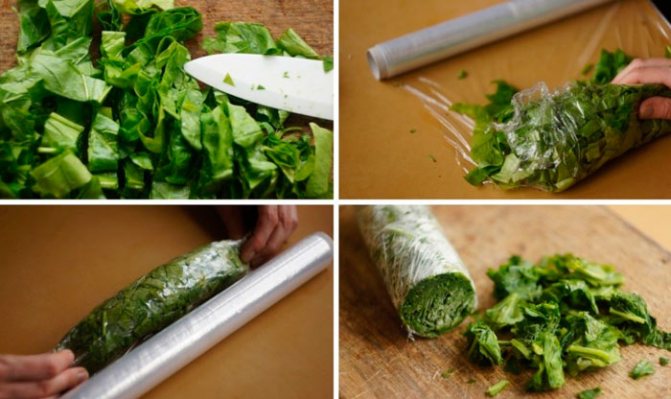

Some herbs recommend blanching, but if you overdo it, you might miss out on the best qualities, so running water will suffice.
If a dense preparation in tins is expected, you can pour boiling water over for a few seconds. Thus, more slices will fit in one cell. Also, depending on the type of weed and convenience, you need to choose a storage method. It is recommended to make small portions of blanks from different mixtures.
Useful Tips
To freeze it successfully, we advise you to use following recommendations:
- It is convenient to freeze greens in plastic bags, silicone molds, plastic containers. Metal or glass containers are not suitable for these purposes.
- Packages with frozen plants need to be made small, for several times of use. If the grass is stored in bunches, then you need to cut it very quickly so that the remaining branches do not have time to defrost. Re-freezing of the product is strictly prohibited.
- When freezing plants in bags, remove all air before placing them in the freezer. A cocktail straw will help in this, which is inserted into a small hole where the bag is closed or tied.
- In the freezer, greens can be kept in the same compartment with vegetables, but not next to meat and fish.
- In bags, you can freeze a mix of vegetables and herbs, soup sets with the addition of greens.
- Chopping the grass is not necessary with the help of cutting objects; a blender will quickly cope with this task.
- If you plan to freeze herbal cubes, it is advisable to use separate molds for this purpose, as they tend to absorb the aroma.
- When freezing simply cut plants, or in cubes, before placing them in bags and an ice mold, they must be doused with boiling water, that is, blanched. It is better to put the grass in a colander for this - so the water will drain quickly. Plants are sent for freezing after they dry out.
- Greens can be frozen in olive oil or butter.
Read also: Soaked apples for the winter: a simple recipe


Freezing is one of the simplest and cheapest ways to prepare food for a long time.Using one of the recipes for freezing greens for the winter, given by us above, you can replenish your body with the necessary vitamins and minerals contained in delicious and aromatic dishes in winter.
Features of storing different types of greens
For storage of different products, those methods are chosen that allow them to preserve their taste and nutritional properties for a longer time.
How to keep green onions fresh?
Green onions are stored in plastic bags, previously wrapped in thick paper. You can wet the bulbs with water and wrap them separately.
You can use damp gauze. Leave the feather dry. Everything is wrapped in paper, then in a bag and sent to storage.
How to store fresh mint?
Save fresh mint in a herb container. If not, use a glass jar or put it in a damp towel.
Shelf life up to 5 days. Mint retains its aroma well when dried, even better when frozen.
Features and storage methods for basil
The leaves or shoots of basil are dried by spreading a thin layer on paper. Store in hermetically sealed jars. Dry using a microwave oven at 700 W.
You can grind the leaves, mix them with olive oil. Freeze in zip bags.
How to store sorrel, spinach?
Sorrel and spinach leaves quickly lose their elasticity, so they are not stored for a long time. They are wrapped in paper, wrapped in a bag.
How to keep dill fresh?
You can keep your dill fresh by using a plastic container. For long-term storage, it is better to freeze.
How to store lettuce leaves?
Lettuce leaves stay fresh longer when placed on a plate. Cover with a paper towel on top, wrap with cling film.
How to store arugula, cilantro?
Delicate arugula and cilantro are kept frozen for a long time. They can be left in a plastic container for 5 days.
How to store celery?
Celery is perfectly stored in any of the following ways. Its leaves are juicy and dense, so they keep well. Once ground, freeze them separately or with other herbs.
How to store wild garlic?
Containers or jars are used for wild garlic leaves. It is recommended to wrap dry leaves with paper and a plastic bag. Stored frozen until next year.
You can cut and pour in vegetable oil, ferment, pickle, pickle. They lose their aroma when dried.
Important! Remember to puncture the ventilation holes.
Drying parsley
A feature of this harvesting method is that both the root of the plant and its leaves can be dried. In both cases, the herb will give up all its beneficial properties and fill the body with vitamins in winter.
Drying the leaves
- To dry parsley leaves for the winter, you must first prepare the plant. Rinse the grass thoroughly under running water and separate the leaves from the stems.
- The separated greens should be laid out on a flat surface on a towel, and when they are completely dry, they should be cut in any shape. The main thing is to make sure that there are no hard parts from the stem of the grass.
- The next step is drying itself. To do this, you can use an electric dryer. It is enough to spread the chopped leaves on baking sheets and set the appropriate temperature.
As a rule, a temperature of 45 degrees is recommended for drying. Leaves should be left for several hours until completely dry. It is good if a powerful fan is built into the dryer: in this case, the greens will dry out much faster. Ready dried parsley is packaged in bags and put away in a closet or closet.
You can also dry the parsley in a regular oven, however, with this option, you will have to monitor the herbs. It is necessary to set the minimum temperature in the oven, evenly distribute the chopped greens on a baking sheet covered with parchment for baking, and leave the product for 5-6 hours.It is better to open the oven door ajar so that the parsley is not “baked”.
The easiest way is to naturally dry the parsley. This is the longest process, but there is no need to keep an eye on the greenery. However, a suitable surface is required.
For example, many housewives prepare herbs and lay them out on the cupboard, covering them with a thin cloth on top to protect them from dust. When dried under natural conditions, you can completely forget about greens until winter.
Drying the root
If you have taken care of the preparation of the plant root in advance and planted a suitable variety, you can dry this part of the useful grass for the winter. To dry the root, rinse it thoroughly, preferably using the hard side of a clean sponge or brush.
Then the "underground" part needs to be cut into thin circles, like a ginger root is cut. To make the slices thin and uniform, it is better to use a vegetable cutter.
You can also dry the root in an electric dryer or oven. When dried under natural conditions, housewives receive a dried root. The finished product should be wrapped in a cotton cloth and stored in a dark, dry and cool place.
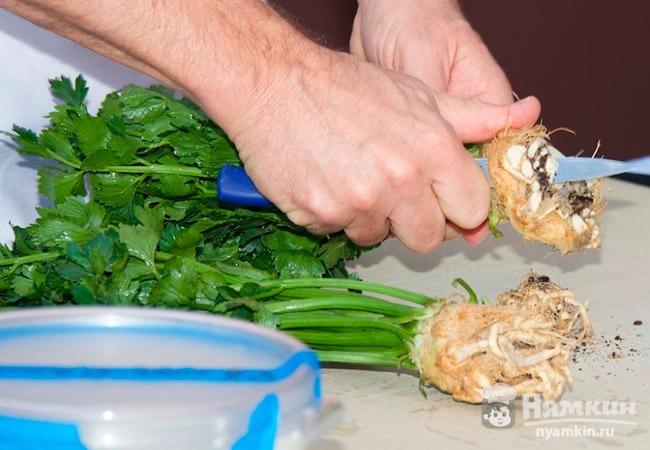

What greens can you freeze
Greens are perhaps best suited for storage such as freezing. After all, it is she who allows you to save most of the valuable substances that make up the plants. And greens are very useful for the human body, and nutritionists everywhere recommend introducing it into the daily diet.
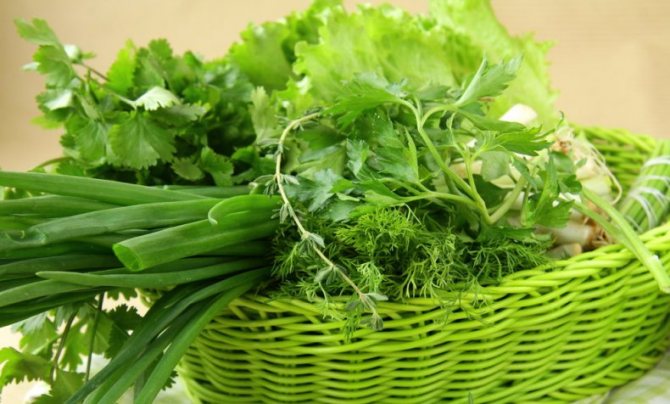

For example, spinach contains up to 25% of the daily iron for the human body, and parsley contains four times more vitamin C than, for example, lemon.
However, not all greens can be frozen. So, do not recommend freezing green onions as they become watery. In addition, it changes its taste and attractive appearance. Although culinary experts claim that there are several recipes, using which this problem can be avoided. For example, add the plant to dishes unfrozen, or freeze onions along with dill or parsley.
Many are interested in whether it is possible to freeze lettuce leaves for the winter. This should not be done either. After thawing, the salad turns into an unattractive porridge that no longer has a fresh taste or smell.
It is also not advised to freeze basil. If there is a need to preserve it for the winter, it is better to use drying. This will keep the flavor better.
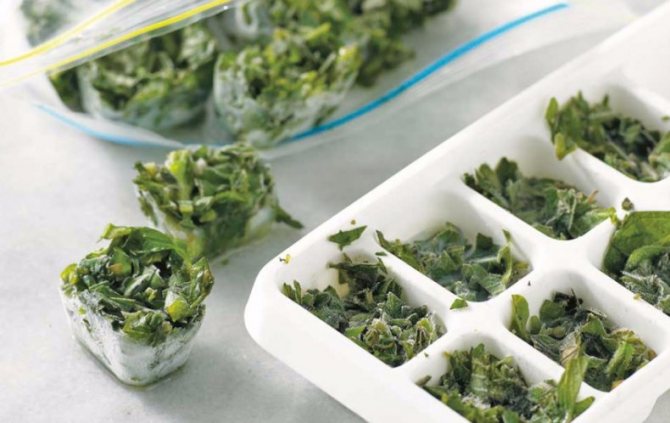

Frozen parsley, dill, sorrel, spinach, nettle, celery are perfect for soup. They can be frozen individually or as a mix.
Read also: How to quickly make pickled apples at home
To decorate dishes
To decorate dishes, you can freeze curly and ordinary parsley, chisel. Greens are also frozen for filling in savory pies. Spinach and green onions work well for this purpose.
An excellent tea is made from frozen mint. You can also freeze tea sets from:
In addition to tea, such frozen broths are perfect for cosmetic procedures, wiping the face.
